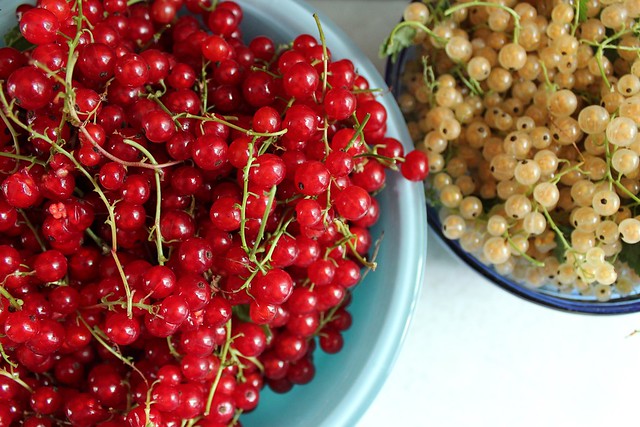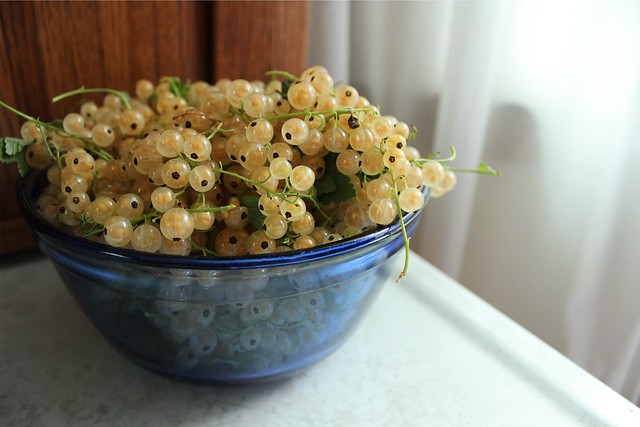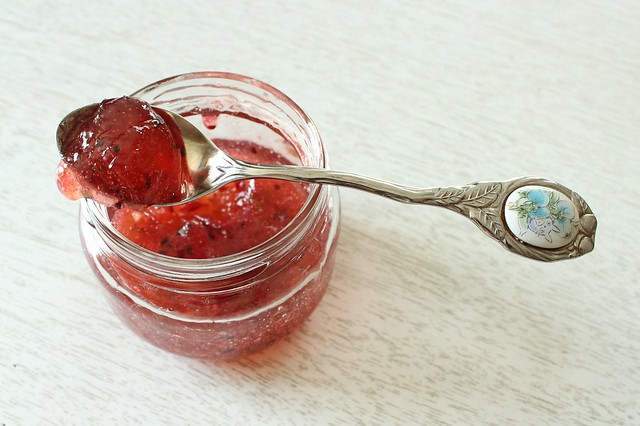I use the term "recent" loosely. It was Monday when I finally got the jars I had my imagination set on completing, and it was Monday when I made the decision to ditch the second little batch of delicious honey-sweetened strawberry-thyme jam (from Food in Jars' latest book, Preserving by the Pint) that had been waiting for me in my covered red leCreuset pot for 4 days. (It smelled fermented, and sadly the berries did not have a pleasant flavor.) Time with two little boys and summer and birthdays got the better of me; I remind myself that it's okay to let things go back to the Earth when time slips like that. That's my Mom's quote, and I think of her each time I forget about some precious leftovers, or get too ambitious and forget to mind my real-life timing.
Last Saturday, we went to Klee's Out on a Limb. I discovered them last year, and make no qualms about calling them my personal orchard now. It's maybe a 20 minute drive, but feels more rural than that. This was the second time I've gotten currants, and not being within days of giving birth as I was last year, I was able to pick them myself (with Candy's help). I tried every variety and since the blackcurrants weren't quite ready, I got red and white. White currants. I think I mentioned 50 times how beautiful those things are, making up for the flavor I felt wasn't quite as good as the red seeing as they weren't as tart. After 5 lbs. in my bucket, I tried some pink currants too - and those had quite a lovely flavor. I have to rein myself in from a currant only preserving season. I think I love them that much.
Transluscent, they look like pearls or fish eggs. My eager baby-eater liked them very much.
Last year, I made cordials out of them. Both were great, though I probably preferred the shrub that turned viscous and thick, a mouth-coating thickness from all the pectin. I actually just finished off the bottle, only tippling tiny cupfuls here and there because it was so sweet. Aged a year, it was still wonderful. I agonize over investing in good rum to make more, and as I do, the extracted red currant juice ages in my fridge. I should decide to can it or freeze it before typing any more, so it doesn't succumb to going back to the Earth too.
I also have a small amount of non-juiced currants left which I need to get into vinegar. Red currant drinking vinegar was my favorite flavored vinegar last year, it barely lasted me a month! I might try it with the white currants and see how I like it. (Note to self: must also invest in another SodaStream seltzer cartridge.)
Seedy currant jam.
Last year, I only made currant jelly - which is so easy I'm not sure there is an easier preserve to tackle. Only slightly more work was currant jam, which uses mostly currant juice (I used red) and a pound of whole, stemmed currants. For juice, you don't need to remove the stems so the process is truly efforless. The 20 minutes spent gingerly plucking the white currants from their tiny green stems was worth it - and I thought the color contrast was beautiful even though I knew it would fade with the cooking.
The jam itself is nicely seedy, tasting tart like the currant jelly, but more interesting and maybe kind of nutty with the seeds. I read that currant seeds are quite healthful too (especially in the blackcurrants, but I figure the other colors must be as well), so it seems like a worthy offset for a sugary preserve.
Nearly a week before the currants, I split a case of peaches with a neighbor. It's the 3rd year I've had "peach truck" peaches, which come from Georgia and are dropped nearby at a number of locations locally. (The service is Tree-Ripe.) I feel like we hit the jackpot, since they harvested Berta peaches for the first trucks of the season. They were some of the best peaches I've had in years, true "drip-down-your-wrist" fruits, with excellent flavor and color. I made a half batch of Marisa's Honey Sweetened Peach Chutney, which I altered slightly to account for my extra spice addiction. A friend gave me a jar of dried Piri Piri chiles last year, and I hadn't used too many of them. I added 15 to the pot - which turned out to be pretty spicy. I fished 4 of them out as I was tasting, but boy those have some good flavor. I also added extra brown mustard seed, and probably more fresh ginger.
Another great thing about this recipe is Marisa's trick of removing peach skins. Simply cut the peaches in quarters, remove the pit of course, and cover with boiling water for 3 minutes. Drain, and the skins slip right off. Amazing! I used the same method to make some fresh peach salsa for our tacos last night, I don't think I'll ever blanch a peach traditionally ever again.
Another great thing about this recipe is Marisa's trick of removing peach skins. Simply cut the peaches in quarters, remove the pit of course, and cover with boiling water for 3 minutes. Drain, and the skins slip right off. Amazing! I used the same method to make some fresh peach salsa for our tacos last night, I don't think I'll ever blanch a peach traditionally ever again.
This stuff is so good that I might use the last of the peaches to make another batch - maybe less spicy for gift giving. I'm definitely hoarding the 4 jars for myself.
In with my currants from Klee's, I had a handful (literally, 58 g.) of gooseberry. I have never tried gooseberry. I can't describe how excited I get to try new things, and at the orchard, I nibbled a bunch of different varities. (I need to remember to bring a notepad and pen there, I can only remember choice things: like that the Newtown Pippen apple was Thomas Jefferson's favorite, and which tree was the mammoth Wolf River variety...) The gooseberries will be on more by this weekend, so I made the tiniest batch of jam ever to see what I could expect.
I used a 6 inch stainless saucepan for this jam.
On some reading, I let them sit around until they were pretty soft and had turned from their bright green to a more rosy color. Then I topped and tailed them (that's a Linda Ziedrich term that seems to really stick in my brain), and weighed them in at a mere 56 g. I added a tablespoon or so of water and steamed them a minute or two to get them softened before adding the same amount of sugar and cooking them down. It was such a small batch that the whole process took less than 10 minutes. The color and flavor were incredible. I'll have to make time to get down there for more!
I really just couldn't get over the color, which I figured was about as close to watermelon-colored as I could describe. The tiny seeds even look like melon seeds too - which I thought was interesting. The flavor of gooseberry jam was different than I expected, though I'm not sure at all what I was expecting. It has a tropical nuance to it, nicely tart but not as tart as the currant it seemed. It feels pectin rich, and has a very firm set - I could have probably simmered it a little less. My tiny batch filled half of a 4 oz. pimento jar, more than I expected, but definitely not enough to satisfy my new gooseberry obsession.
It's a good start to the season, which I have to remind myself is actually here. It's a pleasantly cool summer, with only a handful of 80 degree days so far. It's filled with walks and bike rides (my older son just discovered how fun his first bike can be, and has developed an obsession of his own), fly-by-the-seat-of-my-pants meal planning, and yet another year of a struggling garden. I remind myself that it's not important right now to be cataloging what I do. But, still I love the photographing, and if I seem quiet here, there are still notable things going up on my Facebook page and Flickr. If you have some gooseberry ideas for me, shoot them my way. We'll see what comes of them!
It's a good start to the season, which I have to remind myself is actually here. It's a pleasantly cool summer, with only a handful of 80 degree days so far. It's filled with walks and bike rides (my older son just discovered how fun his first bike can be, and has developed an obsession of his own), fly-by-the-seat-of-my-pants meal planning, and yet another year of a struggling garden. I remind myself that it's not important right now to be cataloging what I do. But, still I love the photographing, and if I seem quiet here, there are still notable things going up on my Facebook page and Flickr. If you have some gooseberry ideas for me, shoot them my way. We'll see what comes of them!
